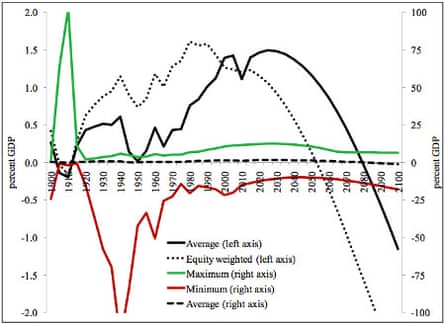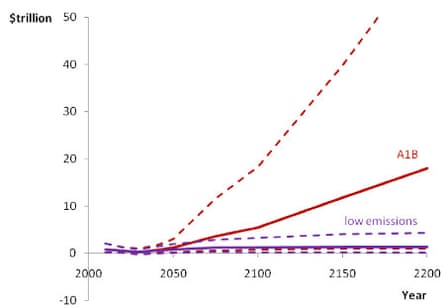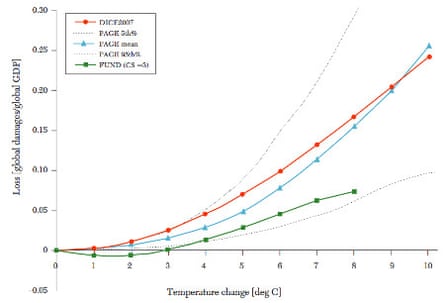The Copenhagen Consensus Center (oddly, located in Massachusetts) is a think tank headed by Bjorn Lomborg that advocates for what they consider "the best ways for governments and philanthropists to spend aid and development money." The group recently released a report that attempts to quantify the economic damage caused by various global problems, including climate change. Regarding climate change and its costs, the group states,
"Climate change is real and man-made ... After year 2070, global warming will become a net cost to the world, justifying cost-effective climate action."
The climate change section was written by Richard Tol, who is one among several economists who have developed what are known as "integrated assessment models," which combine climate and economic modeling to estimate the costs of climate change. The Copenhagen Consensus Center climate costs report focuses on the impacts to global gross domestic product (GDP), and the results from Tol's FUND model are illustrated in the figure below (averages are the black curves).

This figure is based on a scenario in which the average global surface temperature warms by approximately 3.6°C between 1900 and 2100, which is a scenario that would require fairly modest efforts to reduce greenhouse gas emissions.
The modeled economic benefits from climate change come from factors like more carbon dioxide in the atmosphere "fertilizing" agriculture and fewer cold-related deaths. However, there's evidence that we're approaching the point where negative climate-related impacts on plant life offset the benefits from fertilization, and there will be more heat-related deaths in a warmer world.
In the figure above, while the annual impact on the global economy from climate change remains positive until the late 21st century, the solid black curve begins to turn downward after 2025. This means that according to this report, after that date, climate change will have less and less of an annual economic benefit, until it eventually becomes a drag on the global economy. Thus to maximize the impact on the economy, we would stabilize global temperatures at 2025 levels (about 1°C warmer than 1900).
However, we're committed to global warming beyond 1°C from the greenhouse gases we've already emitted. Hence any further human greenhouse gas emissions from here on out will cost us money, according to the Copenhagen Consensus Center Report.
The report also notes that some troubling consequences are overlooked when focusing on the global average economic impact.
"Most countries benefitted from climate change until 1980, but after that the trend is negative for poor countries and positive for rich countries. The global average impact was positive in the 20th century. In the 21st century, impacts turn negative in most countries, rich and poor."
While climate change has continued to increase global average GDP, this has come at the expense of the rich getting richer and the poor getting poorer. This isn't a surprise, given that the poorest countries, who contribute the least to the climate problem, are the most vulnerable to climate change. The report attempts to account for this disparity with an "equity-weighted" economic impact of climate change, illustrated by the black dotted line in the above figure, and concludes,
"the maximum impact of climate change occurs 45 years earlier [in 1980] when equity weighted."
Thus if we weight the impact of climate change on GDP to account for the adverse impact to the economies of poorer countries, according to this report, we reached peak climate economic benefit in 1980. After about 2015, the dotted curve declines steeply.
One shortcoming of the Copenhagen Consensus Center Report is that it only considers one scenario in which we take modest steps to reduce our greenhouse gas emissions, and uses only one integrated assessment model. But what do the results look like when considering other scenarios and models? Economist Chris Hope of the University of Cambridge has another integrated assessment model, PAGE, with which he has run a similar analysis of the cost of climate change under a business-as-usual scenario and a low emissions scenario.

In the PAGE model (which is equity-weighted), climate change is already a drag on the global economy today. According to the model's average result (solid lines), we're able to keep the annual global costs of climate change below $1 trillion until 2050 through adaptation measures, because there's not a big difference in temperature changes between the low and high emissions scenarios until mid-century. After that point, the costs of climate change differ dramatically between the two scenarios. However, achieving the low emissions scenario will require immediate, significant actions to reduce our greenhouse gas emissions.
Prominent Yale economist William Nordhaus also runs an integrated assessment model called DICE. In a 2013 paper in the Journal of Economic Literature, Nicholas Stern compared the results of all three models.

Nordhaus' DICE model agrees well with Hope's PAGE model regarding the negative impacts of climate change on the global economy for 0 to 2°C average global surface warming, after which they only disagree on just how quickly climate change will badly hurt the economy. In his paper, Stern also warned against underestimating the dangers of climate change,
"There are very strong grounds for arguing that [integrated assessment models] grossly underestimate the risks of climate change, not simply because of the limitations of climate and impact models ... but because of the further assumptions built into the economic modeling on growth, damages and risks, which come close to assuming directly that the impacts and costs will be modest, and close to excluding the possibility of catastrophic outcomes."
It's also worth noting that the impacts of climate change can't just be measured in terms of their effect on the global economy. You can put a price tag on the extinction of numerous species, and integrated assessment models account for the costs of these types of factors, but does that adequately reflect their true value? People tend to value social and cultural factors highly.
Robert F. Kennedy once said that GDP measures everything "except that which makes life worthwhile." In Nature, Robert Costanza and colleagues recently wrote that "if a business used GDP-style accounting, it would aim to maximize gross revenue – even at the expense of profitability, efficiency, sustainability or flexibility," and suggested alternatives, like adjusting economic measures to reflect social and environmental factors.
Nevertheless, even by purely economic measures, we've reached the point where additional greenhouse gas emissions will have less economic benefit (or more economic cost, depending on which model is used), and when accounting for the disproportionately negative impact on poorer countries, we reached that point over three decades ago.
One thing that all of these economic analyses agree on is that more global warming will be worse for the economy.

Comments (…)
Sign in or create your Guardian account to join the discussion